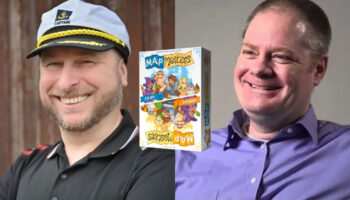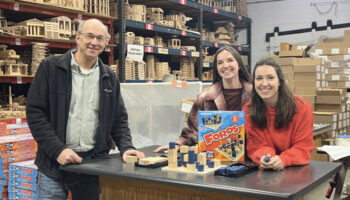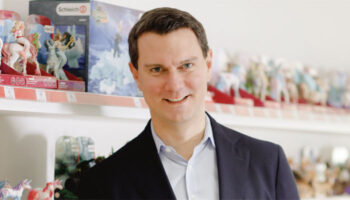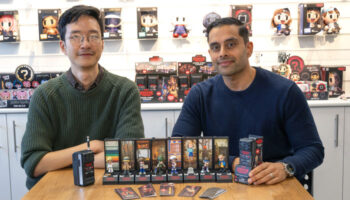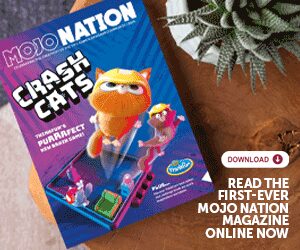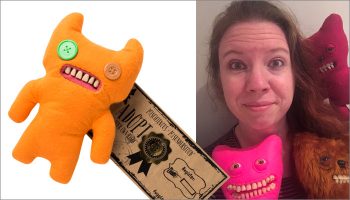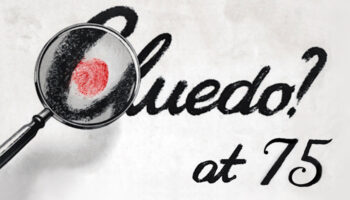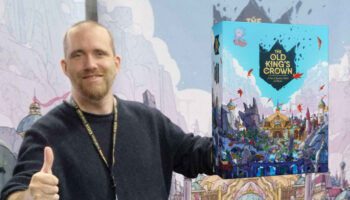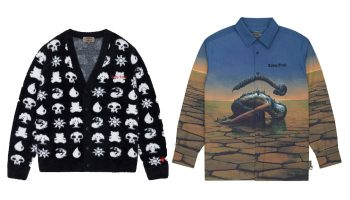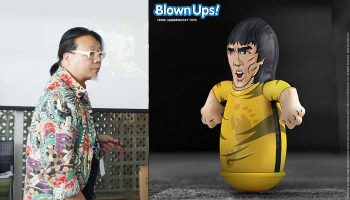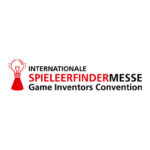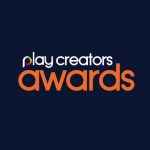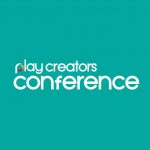The Op’s Tony Serebriany on receiving an Icon Award… And the difference between design and development
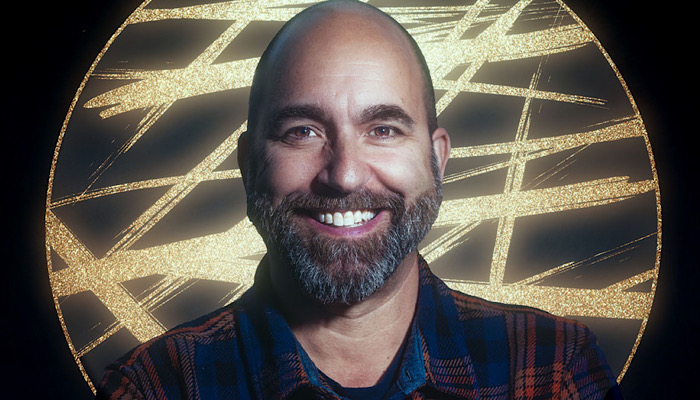
Well, how now best to introduce you? The multi award-winning Tony Serebriany… Ha!
Ah, man!
Ha! I just wanted to see you quail in modesty! Congratulations, though on your Play Creator Awards hatrick. I thought you were terrific on stage, by the way, collecting the Icon Award. Lovely speech.
Thank you so much. I appreciate that.
Not at all. I’ll transcribe it down the bottom if that’s okay with you…
Sure. I was thrilled, actually, that Danielle Reynolds had recorded the whole thing…
You seemed gobsmacked when Billy announced your name for that. Are you not cognizant of the high regard in which you’re held in the industry?
Well, not to that extent! I mean, I had to believe that’s why I won the previous award. Right?
Ha! Right… Inventor Relations Exec of the Year you could accept. Design Icon – bit of a shock.
What I’ve since said about it is that, to me, the Design Icon is almost parallel with the award that was given to TJ and Charlie’s dad, Doug Morrison…
Outstanding Achievement…
The Outstanding Achievement Award! In that somebody is getting it more at the end of their career. You know? “You’ve done this amazing thing!” So on the night, I was like, ‘What? Am I getting kicked out of the club?!’
Yeah! Have you not heard? I thought the memo would’ve got to you by now! Ha!
Ha!
I’m glad you said that… The Design Icon actually only goes to people that are still hitting it out of the ballpark. So you’re safe I think. In any case, you deserve it.
Well… Thanks, Deej.
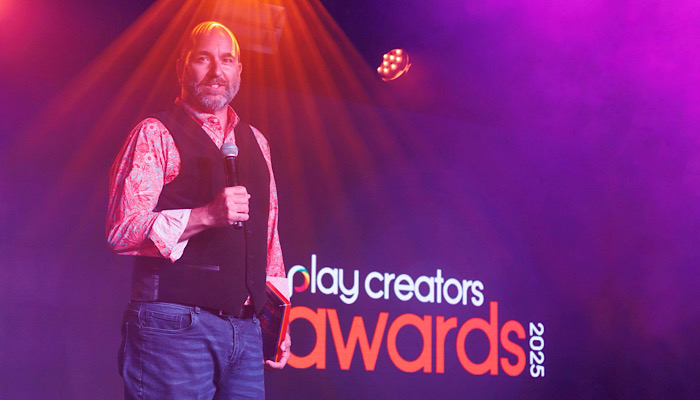
Anyway! At some point during the conference, you briefly spoke about the difference between design and development. I don’t think we’ve discussed that before. So what are some of the differences, Tony?
I think this is a really good question – and I was watching a panel at the San Diego Comic Con yesterday; it was a game-design panel. They had a discussion that sort of led into game design and development… People were asking questions related to how you build the greatest team and who should be on that team. I raised my hand to ask this same exact question… When building the team, how would you differentiate between a designer and a developer?
And what were their answers?
Well, I never got to ask because there were so many other questions! Ha! And I didn’t want to butt in because I knew everybody on the panel, and I knew you and I were going to have a similar conversation. But I personally think the key difference between design and development is that design is the idea, development is making it a reality.
Should we use an example to illustrate this?
I think Dan Klitsner is a good example with Bop It! Dan had this great idea for what was originally going to be a television remote. That was the idea. Over the course of his pitching it and hearing the feedback, the idea turns into this potentially really cool electronic toy. So it’s absolutely his idea, and he helped design it – but it needed a whole slew of engineers and product developers to actually develop that idea into the finished product.
And we’re not saying this behind Dan’s back, of course. As I recall, he gives very generous praise to an industrial designer at Parker Brothers, Bob Welch. People can read that here and here.
Right! Now, Dan has an industrial design background so he theoretically could’ve done a lot of the development work on the structural unit himself. But because it had all the electronics, it had all the programming, and it had all the features related to manufacturing, it was going to need some more development work. So people who are trained in the back end potentially have more stringent considerations when bringing a product to life.
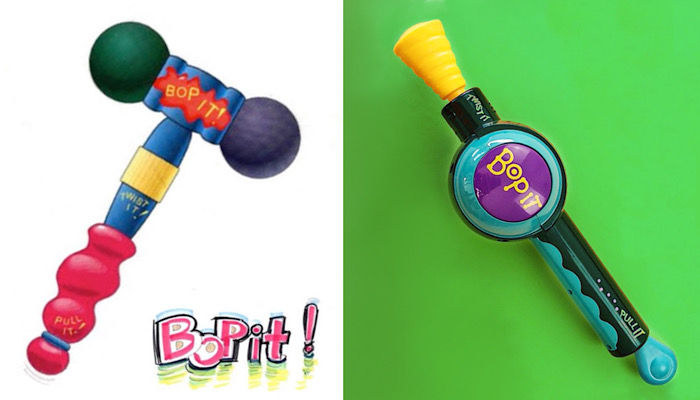
Got it! The masterstroke was making those buttons and toggles intuitive… And that bit WAS Bob Welch! Dan invented it. Parker Brothers developed it.
So as it relates to board games, you can come up with a great idea as a designer… But until you put it through its paces a lot; playtest it, break it and finesse it, you haven’t truly developed it. And I think there’re a number of great game designers that can do 50 to 75, or maybe even 90% of the development work in their early playtesting. But it really isn’t until that last part of the development – in house at a publisher – that an idea really finds its final form. So yes: I think the difference is that a designer creates something to start with… And the developer finishes it off.
And that could include a vast number of variables: theming, adding things or taking them away, say; packaging, costing out or down… So! When you’re personally looking at an designer’s idea, Tony, are you also thinking: well, we could do this or that; it needs more of one thing and less of another?
To some extent, but it really depends on the item. Flip 7’s a great example. When the designer, Eric Olsen, submitted the original presentation, that game was already great. It provided an amazing level of enjoyment, excitement, and engagement – we knew it was already something incredibly special.
As we continued to play it, though, we just kept asking questions; we kept finessing, fine tuning and tweaking. All the while, we were having discussions with Eric because he’d already spent a year and a half or two years playtesting the heck out of it with his design group. But it wasn’t until it was out of his echo chamber and with a whole different group of people – people who hadn’t had the experience of getting it to where it was – that we got to see if it needed any more development.
And how much development did it need?
At its core, only minimal… But what we did find only came through playtesting. So to your earlier question, I wasn’t – the first time I played it – thinking, ‘what would be good?’ We just kept playing it more and more, and we kept asking questions. On other occasions, I’ve seen things that have a lot of stuff in the box and immediately thought: ‘This could deliver an amazing experience, but what would it cost?’ So it really does depend on the idea.
Got it. And to some extent, I suppose there are some designers who have difficulty hearing feedback…
Oh, yes! I’ve seen and been on panels at which new or up-and-coming designers ask questions, and one that comes up a lot is: “How do you deal with feedback? or “How do you get a product ready for pitching?”

I’m loath to interrupt, but I’m quite sure you and I chatted about pitching online way back when! People can read it here. Apologies!
No worries! Because I’ve heard, on more than one occasion – and from some pretty well-seasoned designers – that the answer is that you can’t fall in love with your babies… Meaning that you may have put a lot of ‘sweatequity’ into getting an idea ready to pitch, but you can’t be married to that version as if it’s the final game! That’s because, as I mentioned before, you were in your own echo chamber when you were getting it to that point.
Yes. The idea I’m ready to share is unlikely to be exactly the idea you want to publish. And I need – as a designer – to appear as flexible as the game appears promising.
And you may well have put your game in front of a very robust playtesting group. You may have had a lot of good design feedback to help you hone it. Maybe you even scrapped your original plan and got it on an exciting new path… But if you’re so dead set on the idea you’re showing ending up as exactly what it is, you’re going up against a wall. You mustn’t seem uncooperative or overprotective because – even if you get it signed – you’re going to get pushed back to the point where the publisher may feel it’s easier to drop the product! “We can’t agree. Sorry! We’ll pay you for the guarantee we’ve committed to, and we’ll release it back to you.”
Yikes! That would be crushing.
I would imagine that would be the worst thing for a designer because you had these great expectations and hopes to get it to the finish line. But if you’re so set on what it has to be, then you’re not giving it a chance to go through that final phase of the development side… Which is not the design side! You’ve done your work to get it to the point of development. Right?
Right – that’s a very helpful way to look at it. I’m reminded of a time when a client asked me to trim and proof a designer’s rules. When the designer heard about this, he was absolutely furious! “I’ve DONE the rules; there’s nothing wrong with them! Don’t touch them!” Long story short: he wouldn’t accept it was necessary until I pointed out he’d spelled his own name wrong…
Ha! Really?
Really! Ha! But he was good as gold after that, and we get on very well now. So I put his defensiveness down to passion more than ego…
Yes, I think it’s usually just passion: they want their idea to be right. You and I probably both know a small handful of people where it is more ego…
Shall we name them?! Ha!
Ha! No, but you bring up a great point about the rules. In this panel discussion yesterday, someone in the audience asked about rule writing. Kami Mandell – one of our lead game developers – told how she’d once been working on a product… It was geared towards families with kids aged eight and up. There was a great discussion about how the game that came to us was quite a bit different from what we ended up publishing.
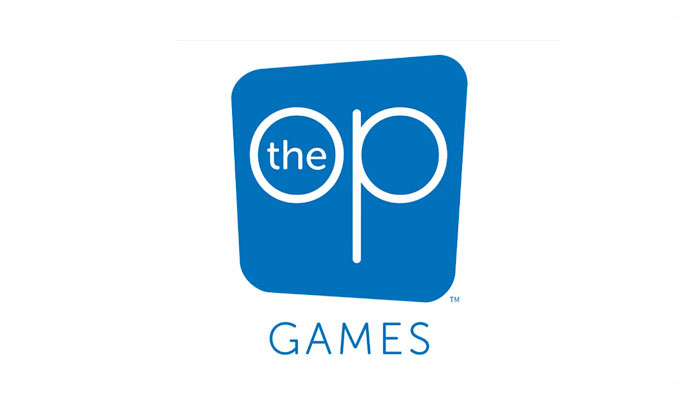
In what way? If that doesn’t seem like a purient question!
When it came in, it didn’t have the theming that we went with. Also, because everyone worked collectively, it felt like a one-story experience. When we worked out how to theme it differently, it became a much richer experience… One that we felt could help turn families into gamers.
At that time, Kami had young daughters while Andrew Wolf – who was the lead on our new business team at the time – was a gamer at heart. They both felt they needed to rewrite the rules but their instincts were to develop the tone with a different audience in mind…
Kami thinking more of a family tone and Andrew thinking more of a hobby tone?
Right. Kami was adamant it should be for families. Andrew wanted it to be a game he could play with his friends and peers. So they both wrote rules and we did some blind testing. That showed it needed to be engaging enough for the leader of that kind of experience, but appeal to a young audience at the same time… But at some point, we also wanted people to be able to put the rules down and just start playing.
This is something that happens a fair bit… There’s a difference between the designer explaining the rules to a playtesting group and what I call a commercial playtest… Where you just shut up, stand back and watch people play.
Yes, because a designer doesn’t arrive with the box; you can’t be an explainer on-site! Blind testing to see if people can figure out how to play a game is a great testament to the whole development side. Flip 7 is a perfect example here as well. The rule set that came to us was very clear. We knew how to play the game right out of the box. But in our development, we had to change those rules here and there… And even after we published, we got some questions. We modified the rules again to make it more clear.
And now I’m cringing at the memory of the worst rules I’ve ever written… After I’d finished them, the publisher changed the game components from 3D playing pieces to cardboard. You had to press them out and assemble them. And the die was now plain – you had to put stickers on it… Lots of little things like that.
This is after you looked at the rules?
Right. But the publisher didn’t develop the rules after they developed the game! You should’ve seen the reviews for it online – “Worst rules ever!”… Brutal! Because nothing in there acknowledged that you had to build half the game before you started. So I’ve come to think that the development stage is like a set of scales… Every time you change one thing, you have to work out if it changes something else.
Wow! You know, I think this might actually make for a good panel at a Mojo Conference… Have a game designer, a toy designer, a game publisher and a toy publisher. And have an open dialogue! Two people from each side of the fence talking about how things change and why they need to work collectively and discuss expectations.
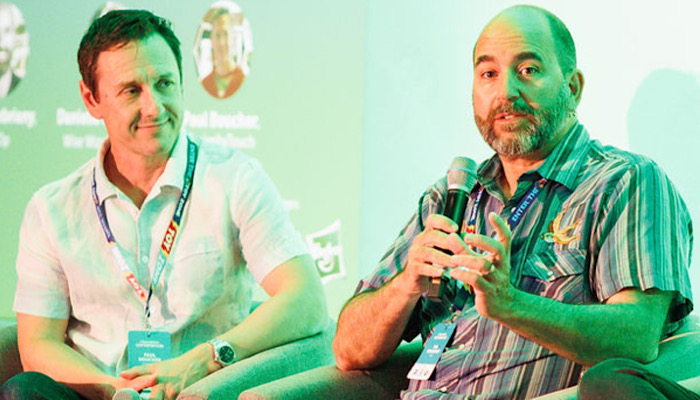
Yes! I’ll put that to Bill; I think he’d be interested in that. Is there anything else we should say on this before we wrap it up?
Only that I think that game designers can continue to develop a game after they think it’s finished by doing what we just talked about… Giving the rule set and game to somebody who’s never seen or played it. Don’t correct them as they’re going through it; just watch them. Make notes!
Yes…
See if they can figure everything out. After they play, ask them all the questions you need answered… Were the rules clear? Did you stumble during play based on any of the rules? Did you have to refer back to the rules? Was the play experience what you expected based on what the goal was listed? Did the length of the playing time mirror your expectations? Would you change anything? If you don’t ask that last question, you might assume they’re not going to want to change anything…
When, in fact, they may not feel confident offering the changes… Fascinating topic. I wonder if some designers are reluctant to ask those questions because – at best – they may get off lightly… At worst, they’re going to get their guts ripped out!
It’s hard to hear.
It’s hard to hear – and it feels like a gamble on which you’re more likely to break even or lose! But somewhere in the middle is a whole bunch of development work that designers might not want to do because they think their game’s finished already. Alright! Let’s wrap it up there, Tony. I’ll finish off with a transcription of Billy’s introduction to your award, and of your speech!
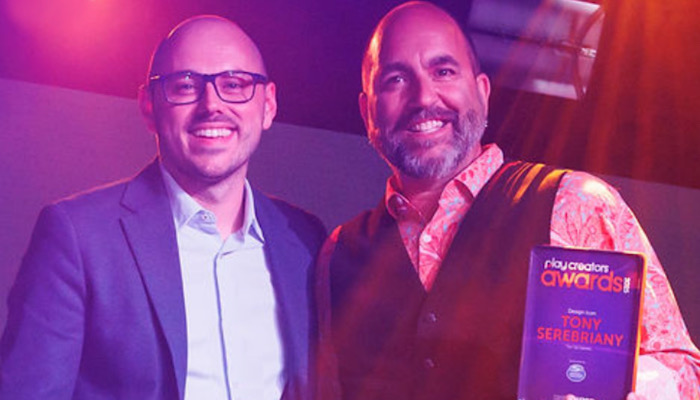
Billy Langsworthy introduces the Play Creators Festival’s Icon Award, 2025
It’s my great privilege to reveal the winner of the year’s Icon Award. This award celebrates those who do incredible work in our industry, continue to be at the very top of their game and are respected and loved by their peers across toy companies and the inventor community alike.
Now, what makes this person an icon. Well, I’ll start by sharing what some fans of this person’s work told us:
“There is no one in the toy and game industry more deserving of this award. It feels like this person knows everybody – but what’s most apparent is that everybody loves them. When people say to me: “Oh, you know them? They’re great!” My response is always: “They’re not just great, they’re the best”.
“They know their stuff, and whether the moment calls for a “cheerleader” or a “team leader,” they’re always there – ready, willing, and able to help. They understand the business, relationships and most importantly, people – they care deeply for the inventor community and have forged close friendships with fellow IR execs at “rival” companies. They’re conviction that “everyone wins” is the true north of this person’s moral compass.”
One tells us: “Always available, engaged, honest and generous with feedback – they’re one of the best at what they do… And they happen to also be a genuine, lovely, fun human being. No-one deserves the status of Icon more.” Another adds: “Along with being fun, kind and trustworthy, this person has a special gift for recognizing great products. Meeting them was a game changer for me in the best possible way.”
Finally, we have: “This person boasts an insatiable passion for play. Whether jumping between airports on intercontinental red eye flights or emerging from a windowless trade show booth after taking nine hours of back-to-back inventor pitches, they still have a smile on their face – and still want to play.
They add: “I’m grateful I get to create, collaborate, and strategize with this person. Cheers to not just one of the best people in the industry, but one of the greatest human beings I know.”
So, I’m delighted to reveal that this year’s Icon is The Op Games’ Tony Serebriany
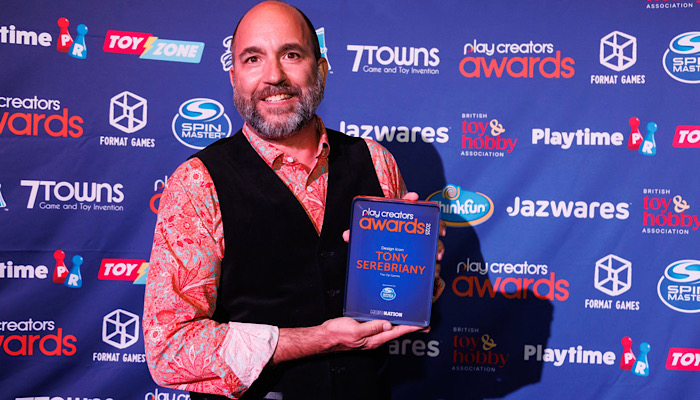
Tony Serebriany collects his award
Totally emotional. Well, that’s… I’m back there talking to Deej. He’s like, “Are you listening?” I’m like, “Yeah. Of course I’m listening!”
But this other award, I feel like an imposter still. You know? It’s amazing to get to do what we do: to bring joy and laughter and help create a lifetime of memories for people literally around the world…
To be recognized by peers and friends and family is the best that there is, because you all know the struggle as well as the passion. So thank you very much. This is absolutely unbelievable. A hat trick for the OP. I can’t believe it.
We feel very blessed. I’m incredibly lucky to get to do what I do. I get to travel the world and meet all of you amazing people who get to help bring amazing products to life and share them with the world. And what can be better than this? Thank you all. I appreciate it.
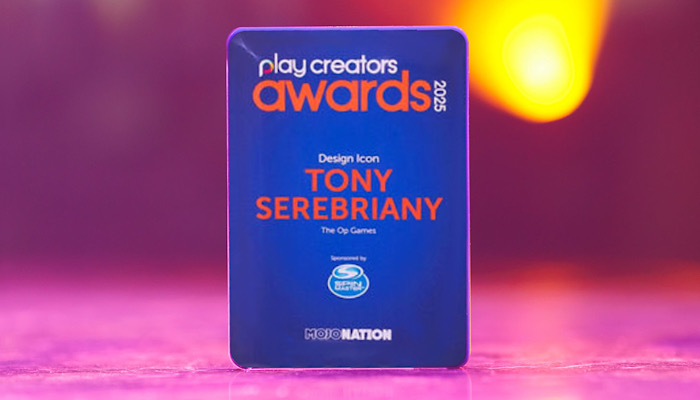
–
To stay in the loop with the latest news, interviews and features from the world of toy and game design, sign up to our weekly newsletter here




